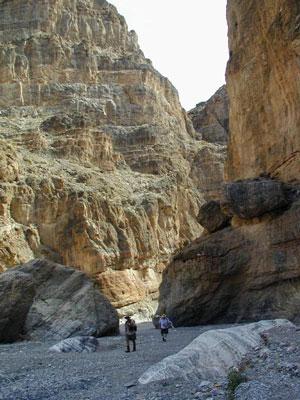The website for Death Valley National Park accurately describes this vast desert area as "Hottest, Driest, Lowest," and a couple of other superlatives would apply to the park as well. Death Valley is the largest NPS area in the Lower 48 and the park has recently announced completion of a plan to manage the "largest area of designated national park wilderness in the contiguous United States."
The park covers nearly 3.4 million acres, and about 91% of that area is designated as wilderness. After a lengthy planning process that began in 2009, the park has selected the preferred alternative from the options developed during that effort. The park will now implement the "Wilderness and Backcountry Stewardship Plan" to guide the future management of congressionally designated wilderness lands within Death Valley National Park.
In addition to guiding management of designated wilderness, the Plan also addresses non-wilderness backcountry concerns, such as backcountry road corridors and campsites, backcountry cabins near roads, and other non-wilderness backcountry lands.
Extensive Road Network Not Affected By Plan
Does wilderness designation of such a large portion of Death Valley unduly restrict public use of the area? The park website notes that "nearly a thousand miles of paved and dirt roads intersect the wilderness, providing ready access to all but the most remote locations." That's more miles of roads than any other national park, open to visitor travel by any street-legal motorized vehicle and by bicycle.
As to travel in the wilderness itself, "Everyone is free to hike or ride horses throughout the wilderness," the site notes. "Although there are few trails and little water, the well- prepared traveler will find a lifetime's worth of exploring. Multi-day camping trips are possible, but even a short walk away from the road will immerse you in the solitude and silence that defines the wilderness experience of Death Valley."

For those who are prepared, Death Valley offers some outstanding backcountry hiking. NPS photo.
One Conservation Group Reacts to Plan
Groups such as the National Parks Conservation Association (NPCA) haven't always been happy with NPS plans in recent years, but David Lamfrom, senior program manager for the California Desert at the NPCA, says this one sets a model for similar efforts elsewhere.
Lamfron recently commended "the unprecedented, forward-thinking approach that Death Valley National Park followed," saying it "takes into consideration the natural and intrinsic values that attract its nearly one million annual visitors, such as open space and pristine night sky, as well as the solitude that many seek in the park's deep quiet spaces."
Changes in the Backcountry
The plan calls for new trail heads and marked routes at Indian Pass, Dante's Peak, Eureka Dunes, and Sidewinder Canyon, changes to camping sites, and new pit toilets. A permit system will be developed for canyoneering and group photography and hiking, as well as new rules on various events such as the Historic Wagon Train Event and Historic Equestrian Event. Permits will be required on all wilderness and some overnight back country use.
"The way people think about wilderness is that it manages itself," Lamfrom said. "Once it's designated, that's the end of it. But we've learned over time that places really don't manage themselves. It takes love and care over the long term by generations to have things like national parks. The thing we have at Death Valley that you don't have anywhere else in the lower 48 is that deep, deep wilderness experience and the goal is to protect that."
You'll find a link to the document at this link.


 Support Essential Coverage of Essential Places
Support Essential Coverage of Essential Places







Comments
Thank you, Jim Burnett, for this news of DEVA's wilderness plan. It is one of my favorite parks of all time.
Death Valley is a great hiking destination in late fall and winter. There are some fascinating canyons to explore. If you go during the hot season you can hike on Wild Rose and Telescope peaks, which, at 11,000 feet elevation, are nice and cool.